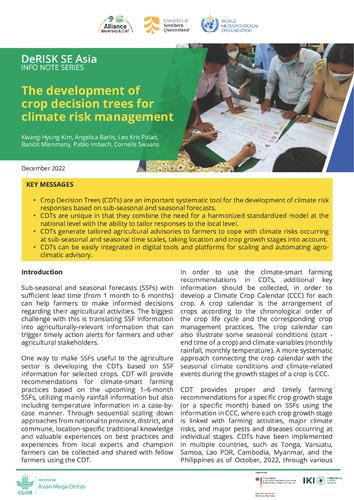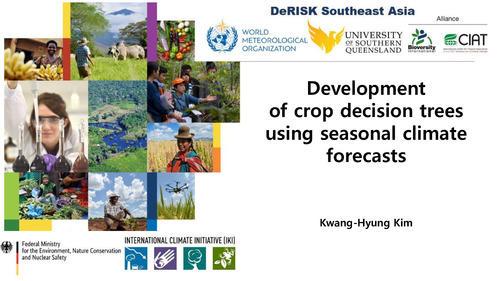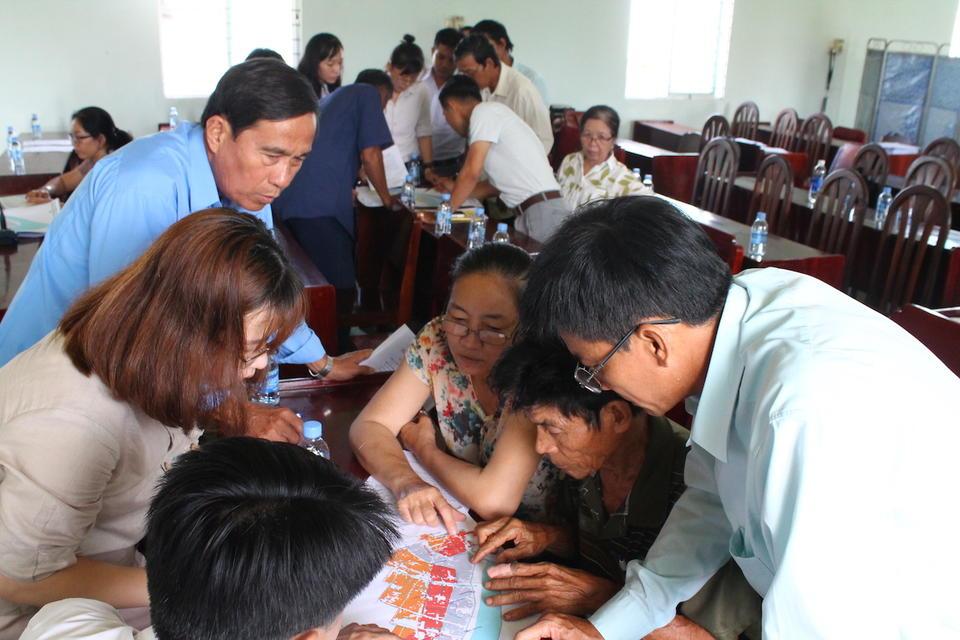Crop decision trees for climate risk management

Crop decision tree is a systematic tool for the development of climate risk responses based on sub-seasonal and seasonal forecasts. This generates tailored agricultural advisories to farmers to cope with occurring climate risks taking location and crop growth stage into account.
Crop Decision Trees (CDTs) will provide recommendations for climate-smart farming practices based on the upcoming 1–6-month sub-seasonal and seasonal forecasts (SSFs), utilizing mainly rainfall information but also including temperature information in a case-by-case manner. Through sequential scaling down approaches from national to province, district, and commune, location-specific traditional knowledge and valuable experiences on best practices and experiences from local experts and champion farmers can be collected and shared with fellow farmers using the CDT.
In order to use the climate-smart farming recommendations in CDTs, additional key information should be collected, in order to develop a Climate Crop Calendar (CCC) for each crop. A crop calendar is the arrangement of crops according to the chronological order of the crop life cycle and the corresponding crop management practices. The crop calendar can also illustrate some seasonal conditions (start -end time of a crop) and climate variables (monthly rainfall, monthly temperature).
CDT provides proper and timely farming recommendations for a specific crop growth stage (or a specific month) based on SSFs using the information in CCC, where each crop growth stage is linked with farming activities, major climate risks, and major pests and diseases occurring at individual stages.
Structure of CDT
CDT consists of (i) a CCC with crop growth stages and climate risks, (ii) Seasonal climate (mostly
rainfall) scenario-based farming recommendations representing Best Farming Practices (BFPs)
available in the target area (national/provincial/district), and lastly (iii) Farming advisories to cope with climate risks taking place at specific crop growth stages.
In what context is this tool useful?
This tool is useful in a context where farmers are facing the challenge of translating sub-seasonal and seasonal forecasts information into agriculturally-relevant information that can trigger timely action alerts for them and other agricultural stakeholders.
CDTs have been implemented in multiple countries, such as Tonga, Vanuatu, Samoa, Lao PDR, Cambodia, Myanmar, and the Philippines as of October, 2022, through various international projects including DeRISK SE Asia.
Based on the experiences in multiple countries, including those of the DeRISK SE Asia, the top-down approach, from national to local, resulted in the most effective and efficient process for the development of CDTs for most countries. This is due to the availability of general and standard knowledge in the central level, which could be complemented by the field-oriented knowledge and experiences at the local level.
Contact people
- Dr. Kwang-Hyung Kim ([email protected]) is DERISK SEA chief technical advisor at ABC.
- Ms. Angelica Barlis ([email protected]) is DERISK SEA project manager at the Alliance of Bioversity International and CIAT.
- Mr. Leo Kris Palao ([email protected]) is a climate risk and adaptive capacity specialist, an ex-CIAT member and the former DeRISK SE Asia Laos Country Coordinator.
- Mr. Bandit Mienmany is an ex-CIAT member and coordinator of DeRISK SE Asia in Lao PDR.
- Dr. Pablo Imbach is an ex-CIAT member and worked as climate scientist and former lead of DeRISK SE Asia.
- Dr. Cornelis Swaans ([email protected]) is a senior scientist and Alliance regional lead for climate action in Asia.



